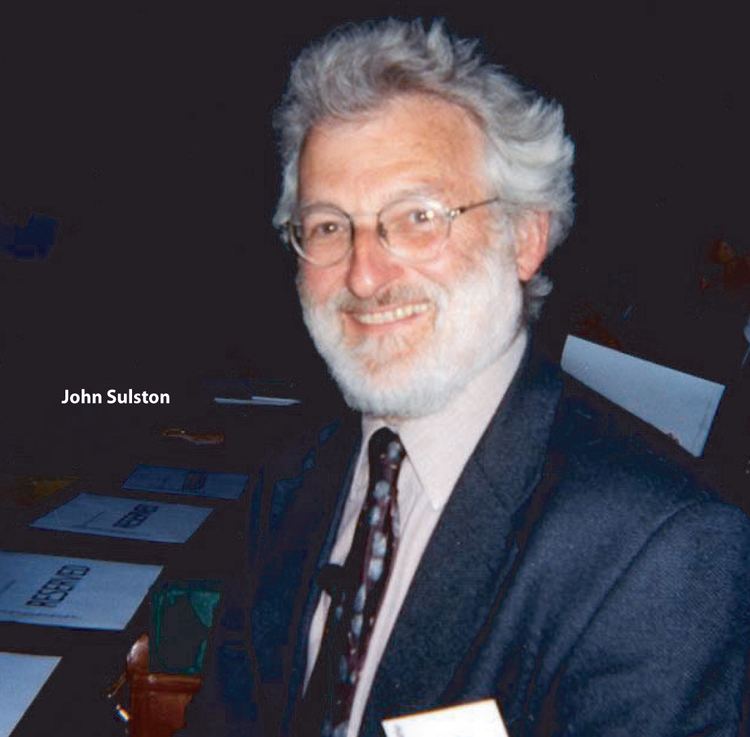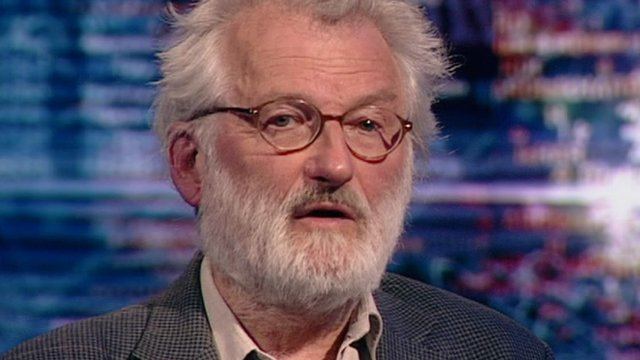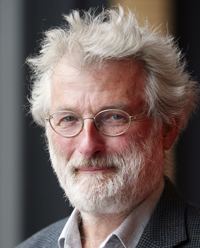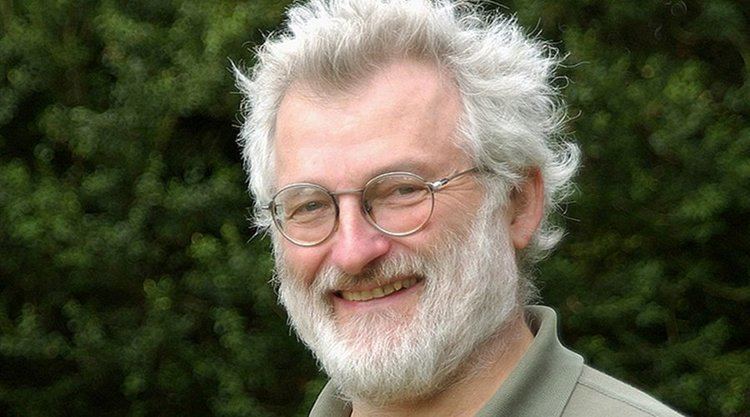Citizenship Britain Role Biologist Name John Sulston | Doctoral advisor Colin Reese Nationality English | |
 | ||
Born John Edward Sulston 27 March 1942 (age 83) Cambridge, England ( 1942-03-27 ) Institutions Wellcome Trust Sanger InstituteUniversity of CambridgeSalk InstituteLaboratory of Molecular BiologyUniversity of Manchester Thesis Aspects of oligoribonucleotide synthesis (1966) Books El Hilo Comun de La Humanidad Similar People H Robert Horvitz, Sydney Brenner, Bob Waterston, Eric Lander, Georgina Ferry | ||
Interview of sir john sulston part one
Sir John Edward Sulston, (born 27 March 1942) is a British biologist and academic. For his work on the cell lineage and genome of the nematode Caenorhabditis elegans, he was jointly awarded the 2002 Nobel Prize in Physiology or Medicine with Sydney Brenner and Robert Horvitz. As of 2014 he is Chair of the Institute for Science, Ethics and Innovation at the University of Manchester.
Contents
- Interview of sir john sulston part one
- Sir john sulston society and health tue 7 july
- Early life and education
- Career
- Awards and honours
- Personal life
- References

Sir john sulston society and health tue 7 july
Early life and education

Sulston was born in Cambridge to parents The Reverend Canon Arthur Edward Aubrey Sulston and Josephine Muriel Frearson (née Blocksidge). His father was an Anglican priest and administrator of the Society for the Propagation of the Gospel. An English teacher at Watford Grammar School, his mother quit her job to care for him and his sister Madeleine. His mother home-tutored them until he was five. At age five he entered the local preparatory school (York House School, Redheath) where he soon developed aversion to games. He instead developed an early interest in science, having fun with dissecting animals and sectioning plants to observe their structure and function. Sulston won a scholarship to Merchant Taylors' School, Northwood and then to Pembroke College, Cambridge graduating in 1963 with a Bachelor of Arts degree in Natural Sciences (Chemistry). He joined the Department of Chemistry, University of Cambridge, after being interviewed by Alexander Todd and was awarded his PhD in 1966 for research in nucleotide chemistry.
Career

Between 1966 and 1969 he worked as a postdoctoral researcher at the Salk Institute for Biological Studies in US. His supervisor Colin Reese had arranged for him to work with Leslie Orgel, who would turn his scientific career in a different pathway. Orgel introduced him to Francis Crick and Sydney Brenner, who were working in Cambridge. He became inclined to biological research.

Although Orgel wanted Sulston to remain with him, Sydney Brenner persuaded Sulston returned to Cambridge to work on the neurobiology of Caenorhabditis elegans at the Medical Research Council Laboratory of Molecular Biology. Sulston soon produced the complete map of the worm's neurons. He continued work on its DNA and subsequently the whole genome sequencing. In collaboration with the Genome Institute at Washington University in St. Louis the whole genome sequence was published in 1998, so that C. elegans became the first animal to have its complete genome sequenced.

Sulston played a central role in both the C. elegans and human genome sequencing projects. He had argued successfully for the sequencing of C. elegans to show that large-scale genome sequencing projects were feasible. As sequencing of the worm genome proceeded, the project to sequence the human genome began. At this point he was made director of the newly established Sanger Centre (named after Fred Sanger), located in Cambridgeshire, England.
Following completion of the 'working draft' of the human genome sequence in 2000, Sulston retired from his role as director at the Sanger Centre. With Georgina Ferry, he narrates his research career leading to the human genome sequence in The Common Thread: A Story of Science, Politics, Ethics, and the Human Genome (2002).
Awards and honours
Sulston was elected a Fellow of the Royal Society (FRS) in 1986. His certificate of election reads:
He was elected an EMBO Member in 1989 and awarded the George W. Beadle Award in 2000. In 2001 Sulston gave the Royal Institution Christmas Lectures on The Secrets of Life. In 2002 he won the Dan David Prize and the Robert Burns Humanitarian Award. Later, he shared the Nobel Prize in Physiology or Medicine with Sydney Brenner and Robert Horvitz, both of whom he had collaborated with at the MRC Laboratory of Molecular Biology (LMB), for their discoveries concerning 'genetic regulation of organ development and programmed cell death'. One of Sulston's most important contributions during his research years at the LMB was to elucidate the precise order in which cells in C. elegans divide. In fact, he and his team succeeded in tracing the nematode's entire embryonic cell lineage. Sulston is now a leading campaigner against the patenting of human genetic information.
In 2013, Sulston was awarded the Royal Society of New Zealand's Rutherford Memorial Lecture, which he gave on the subject of population pressure.
He was appointed Member of the Order of the Companions of Honour (CH) in the 2017 Birthday Honours for services to science and society.
Personal life
John Sulston met Daphne Bate, a fellow research student in Cambridge. They got married in 1966 just before they left for US for postdoctoral research. Together they have two children. The first child Ingrid was born in La Jolla in 1967, Adrian later in England.His grandson Micah was born in 2001, followed by his granddaughter Kira in 2003.
Although brought up in a Christian family, Sulston lost his faith during his student life at Cambridge, and remains an atheist. He is a distinguished supporter of the British Humanist Association. In 2003 he was one of 22 Nobel Laureates who signed the Humanist Manifesto.
Sulston is in favour of free public access of scientific information. He wants genome information freely available, and he has described as "totally immoral and disgusting" the idea of profiteering from such research. He also wants to change patent law, and argues that restrictions on drugs such as the anti-viral drug Tamiflu by Roche are a hindrance to patients whose lives are dependent on them.
Sulston provided bail sureties for Julian Assange, according to Mark Stephens, Julian's solicitor. Having backed Julian Assange by pledging bail in December 2010, he lost the money in June 2012 when a judge ordered it to be forfeited, as Assange had sought to escape the jurisdiction of the English courts by entering the embassy of Ecuador.
